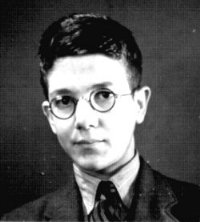Buzz-bombs' and 'Doodlebugs'
This article is a copy of an article which first appeared at http://atschool.eduweb.co.uk/chatback/english/memories/doodbug.html
but which seems to have 'gone down'.
The memories of Bernard Bergonzi
In June 1944 the first flying bombs fell on London; they were usually called 'buzz-bombs' or 'doodle-bugs'. It was not clear what they were at first, as they were obviously not dropped from a plane. Then it was understood that they were in effect self-propelled pilotless aircraft, which when they reached their maximum range would crash with their explosive load. At first only one or two fell, but soon it became obvious that a regular bombardment was under way.
The most noticeable aspect of the doodlebugs was their sound, which was quite unlike any ordinary plane; it had a strange tearing and rasping sound, more like a two-stroke motor-cycle. It soon acquired a sinister and disturbing quality, and prompted ignoble reactions. If the motor cut out when the weapon was approaching, then it was likely to drop nearby and one tried to take shelter; if it continued its flight, one could feel relieved: someone else would be the victim. South London was on their regular flight path, and many of them fell nearby, causing damage and loss of life. Our house suffered broken glass and a ceiling down but no serious damage.
There was a particularly bad incident on (as I have since discovered) 28th July 1944 when a flying bomb fell in the main shopping centre of Lewisham; it penetrated an air raid shelter, causing 51 deaths and many casualties. At about that time I was in a street about a quarter of a mile away, conscious of all the nearby disturbance; what I remember most clearly was seeing bloodstains on the pavement. Looking back, I am struck by the very matter of fact way in which at that age I responded to all this.
In August 1944 I went to stay with an uncle who lived in a village near Canterbury in Kent. This was out of the way of the flying bombs in one sense, as they were directed at London; but they often passed overhead as the village was situated in what was called Doodlebug Alley. Sometimes they would fall in the nearby fields, either because they had fallen short, or were shot down by fighters. The RAF brought the first jet fighters into operation to try to catch them as they were much faster than piston-engined fighters. They would fly alongside them and flip their wing to spill them harmlessly into the open fields below.
I remember sitting on the North Downs with my cousin and his girl-friend, and seeing a fighter chasing a doodlebug. It crashed somewhere in the distance, which was an exciting spectacle, either shot down or tipped off course by the pursuing plane. Some of them failed to explode and one was put on display at a store in Canterbury.
There is no doubt that these things did a great deal of damage in London within the space of a few weeks. The allied armies were advancing on the launching sites in Northern France and Belgium, and there was concern that they would not get there in time to prevent more damage and loss of life.
Soon, however, they were replaced by the far more frightening V2 weapons. These were rockets proper, much larger and more destructive which gave no notice at all of their arrival, and they continued to fall on London at intervals during the last winter of the war, 1944-45. |
Bernard Bergonzi
 In
1944 I was a schoolboy of 15. I had not been in London during the Blitz
of 1940-41, but I returned to the family home in South London in 1942
and went to school there. It has to be remembered that for nearly three
years, from 1941 to 1944, there was almost no bombing at all. Then in
February 1944 Germany launched what became known as the 'little Blitz'.
This went on for a few days, but was on nothing like the scale of the
bombing of 1940-41, still less the massive Anglo-American air raids then
being directed at Germany.
In
1944 I was a schoolboy of 15. I had not been in London during the Blitz
of 1940-41, but I returned to the family home in South London in 1942
and went to school there. It has to be remembered that for nearly three
years, from 1941 to 1944, there was almost no bombing at all. Then in
February 1944 Germany launched what became known as the 'little Blitz'.
This went on for a few days, but was on nothing like the scale of the
bombing of 1940-41, still less the massive Anglo-American air raids then
being directed at Germany.